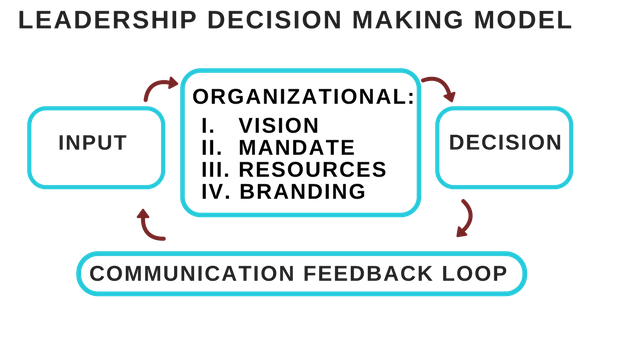Home › Jitsutech University › Thursday Thinktank › Leaders have decisions, decisions, decisions…
-
AuthorPosts
-
August 17, 2018 at 10:27 am #1534
Anonymous
InactiveLeaders have decisions, decisions, decisions…
Leaders are constantly required to make daily decisions that impact others. These decisions could be about jobs to take, task distribution, cost-to-profit ratios, staffing levels or completion timelines and the list goes on. To be an effective organizational leader, you should be aware of how to get these decisions right most of the time. Here are 3 tips to establish your decision-making model.
Tip #1 Organizational Components
There are four main organizational components that are reliable measures for decision making and are often overlooked. The first component is organizational vision. A vision is an organizational backbone as it guides an organization by providing purpose and therefore a clear direction. An organizational vision goes hand in hand with the second organizational component of organizational mandate. The goals and objectives of an organization also known as a mandate or the purpose of a business. A mandate provides a driver and motivation for decision making. The third organizational component requires a review and assessment of actual organizational resources (time, energy, people, money) rather than ideal resources. This component defines an organization’s true capacity and quality of task completion. The final organizational component is branding. Branding provides complete awareness of the services required by clients and continues in “know thy customer” zone. A leader using all four components will stay within the bandwidth of the organizational: purpose, driver, resource capacity, and clientele.
Additionally, a decision-making model should be flexible enough to adapt to changes while keeping clear priorities. Once a model is established the next step requires consistent two-way team communication channels with an on-going objective feedback loop to make adjustments. Do not miss the essential step in assigning and communicating clear team priorities as inefficiencies will develop. As well, if an organization is missing components for example a clear vision then resources will be inevitably mismanaged. For example, I worked for an organization that changed priorities so regularly that tasks were never completed however, results were expected. It was a cycle of unrealistic expectations with constant let downs both of myself and the organization.

Tip #2 Establish Systems of Operation
Systems of operation allows a business to grow beyond an entrepreneur stage by using consist operating standards by everyone in the organization. The advantage to a decision-making model becomes recognized by the simplicity of many decisions made by established protocols without disrupting business efficiency. One example of an inefficient organization is how regularly 2 or 3 employees stop and assist one client. If this scenario is consistently the case, an organization is losing out on 1-2 employees assisting other clients. What is the lost in revenue of this practice in one transaction over a day, month, year etc? It’s a guarantee that without a system there will be a loss of resources within an organization.
Tip #3 Organizational Needs Come First
As leaders sometimes we use the wrong navigation system to make decisions and rely on personal bias rather than the organizational needs. Since it’s only natural to want to deal with xx client because they mesh with our personal beliefs, values or interests however they do not actually work with the organizational needs. For example, in hiring for a new position you decide to hire a less qualified candidate because they are your friend. This action may feel and comfortable as you are aware of their attributes and can trust their qualifications although they may not meet the requirements of the actual job. To keep organizational needs clear and as a business driver ensure an organizational manual is created and referenced.
Effective leaders know decisions are not always easy to make but they can be using: the four organizational components, establishing systems of operation, and putting the needs of the organization first. Focus mentoring group is accepting new clients and we enjoy working with leaders to ease your decision making.
-
AuthorPosts
- You must be logged in to reply to this topic.
